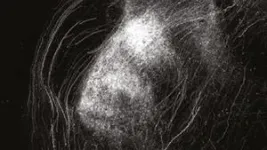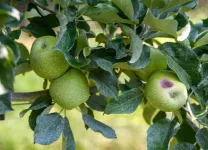(Press-News.org) Imagine you’re at a dinner party, but you can’t smell the food cooking or hear the dinner bell. Sounds like a dream, right? What if it wasn’t?
“When we experience the world and interact with people, we use all our senses,” Cold Spring Harbor Laboratory Professor Stephen Shea says. “That’s true for animals and humans.” However, that’s not always the case in developmental disorders like autism. These conditions can affect how the brain processes incoming information, making it difficult to interpret the social cues that drive conversations, dates, and other interpersonal activities.
Exactly how such signals mix and influence each other in the brain isn’t well understood. To shed light on the subject, Shea and graduate student Alexander Nowlan traced how smell and hearing interact in mouse brains during a maternal behavior called pup retrieval. This activity isn’t limited to mothers. It can also be learned by surrogates. Think stepmoms and babysitters.
“Pup retrieval is one of the most important things for mothers or caregivers. It requires the ability to smell and hear the pup. If these things are both important, that may mean they merge somewhere in the brain. One interesting thing we found was a projection from a location called the basal amygdala (BA)," explains Shea.
In mice and humans, the BA is involved in learning and processing social and emotional signals. During pup retrieval, the team found that BA neurons carry smell signals to the brain’s hearing center, the auditory cortex (AC). There, they merge with incoming sound signals and influence the animal’s response to future sounds—like pups’ cries. Amazingly, when Shea’s team blocked maternal mice from accessing smell signals, their pup retrieval response almost completely broke down.
“We think what’s reaching the AC is being filtered through social-emotional signals from BA neurons,” Shea explains. “That processing can be impaired in autism and neurodegenerative conditions. We think many parts of the brain participate in this behavior and that it’s very richly controlled.”
Shea’s lab is now exploring how these brain regions connect and interact with one another. Their work may lead to a better understanding of how autism can affect a person’s ability to interpret social cues. But that’s just the beginning.
“The idea that we found a neural circuit that may allow emotional processes to directly interact with perception is very exciting to me,” Shea says. He’s not alone there. His research might yet provide answers to one of humanity’s oldest questions. How do our senses inform the ways we connect with one another and experience the world?
END
Mixed signals: How the brain interprets social cues
2025-01-06
ELSE PRESS RELEASES FROM THIS DATE:
Climate extremes in 2024 ‘wreaking havoc’ on the global water cycle
2025-01-06
2024 was another year of record-breaking temperatures, driving the global water cycle to new climate extremes and contributing to ferocious floods and crippling droughts, a new report led by The Australian National University (ANU) shows.
The 2024 Global Water Monitor Report, involving an international team of researchers and led by ANU Professor Albert van Dijk, found rising temperatures are changing the way water moves around the planet, “wreaking havoc” on the water cycle.
“Rising ...
Acoustic sensors find frequent gunfire on school walking routes
2025-01-06
COLUMBUS, Ohio – A new study used acoustic sensors that detect the sound of gunfire to show how often children in one Chicago neighborhood are exposed to gunshots while walking to and from school.
Results showed that nearly two-thirds of schools in the Englewood neighborhood of Chicago had at least one gun incident within 400 meters (about one-quarter mile) of where children were walking home during the 2021-22 school year.
These findings suggest a need to redefine federal definitions of school gun violence to include indirect forms of violence that take place near schools, not only on school grounds, in order to more appropriately ...
New quantum sensing technology reveals sub-atomic signals
2025-01-06
Since the 1950s, scientists have used radio waves to uncover the molecular “fingerprints” of unknown materials, aiding in tasks as varied as scanning the human body with MRI machines and detecting explosives at airports.
These methods, however, rely on signals averaged from trillions of atoms, making it impossible to detect tiny variations between individual molecules. Such limitations hinder applications in fields like protein research, where small differences in shape control functionality and can determine the difference between health and disease.
Sub-Atomic Insights
Now, engineers at the University of Pennsylvania ...
Significant funding to ensure personalized treatments that work for rheumatoid arthritis
2025-01-06
In recent years treatment with powerful biologic and targeted synthetic therapies has changed the landscape for arthritis, but currently finding the right treatment for each person is a matter of trial and error. Only a proportion of patients with inflammatory arthritis respond to each expensive therapy, which results in unnecessary treatment and a long and often frustrating journey for patients, not to mention significant cost to the NHS.
University of Birmingham researchers have just been awarded £3.5 million funding from Johnson & Johnson to investigate ...
CryoSCAPE: Allen Institute scientists develop ‘suspended animation’ technique for blood draws that will aid research for underserved populations
2025-01-06
By Rachel Tompa, Ph.D
Your blood is a delicate mixture. Researchers and clinicians often use blood to learn what’s going on inside our bodies, in part because siphoning off a tube of blood is easier and less painful than taking biopsies of an internal organ.
But in some cases, it turns out that blood can be very different outside our bodies. When it comes to certain emerging research techniques, the clock starts ticking as soon as your blood hits the tube. As little as six to eight hours later, some aspects of your blood’s ...
Prime apple growing areas in US face increasing climate risks
2025-01-06
VANCOUVER, Wash. – Some of the most productive apple regions in America are facing big challenges from a changing climate, according to a Washington State University study.
Researchers analyzed over 40 years of climate conditions that impact the growth cycle of apple trees from bud break and flowering through fruit development, maturation and color development.
While many growing areas are facing increased climate risks, the top three largest apple producing counties in the U.S. were among the most impacted: Yakima in Washington, Kent in Michigan and Wayne ...
Extended Paxlovid may help some people with long COVID
2025-01-06
An up-close look at how patients respond to the drug at different times and doses adds nuance to a recent finding that Paxlovid does not work for long Covid.
An extended course of Paxlovid appears to help some patients with long Covid, according to a case series by UC San Francisco researchers that suggests this treatment option holds promise for some of those struggling with debilitating symptoms.
These results are at odds with recent research that has failed to show the antiviral can alleviate persistent symptoms of the disease. The authors said more study is needed to find out which patients may benefit from the drug and how long it should be given.
The ...
Media coverage of civilian casualties in allied countries boosts support for U.S. involvement
2025-01-06
From photographs of decimated buildings to military and civilian casualty counts to narratives of suffering, news media bring information about foreign conflicts to American audiences. But does this coverage actually affect public opinion about whether and how the United States should be involved in a conflict? Does it influence what Americans think about the U.S. providing military, diplomatic, and economic aid to foreign nations?
A new paper from researchers at the Annenberg Public Policy Center (APPC) of the University of Pennsylvania examines these questions and finds that media coverage of civilian casualties increases public support for U.S. involvement in conflicts by evoking empathy ...
Marked decrease in Arctic pressure ridges
2025-01-06
In the Arctic, the old, multiyear ice is increasingly melting, dramatically reducing the frequency and size of pressure ridges. These ridges are created when ice floes press against each other and become stacked, and are a characteristic feature of Arctic sea ice, an obstacle for shipping, but also an essential component of the ecosystem. In a recently released study in the journal Nature Climate Change, experts from the Alfred Wegener Institute report on this trend and analyse observational data from three decades of aerial surveys.
Satellite data from the last three decades documents the dramatic changes in Arctic sea ice due to climate change: the area covered in ice in summer ...
Age matters: Kidney disorder indicator gains precision
2025-01-06
Annual health checkups regularly include urine tests that serve several purposes, including checking for symptoms of kidney disease. The presence of albumin in the urine is one indicator as is glomerular filtration rate. In diabetic nephropathy, albuminuria first appears, leading to excessive filtration and eventually a decrease in GFR.
In the elderly, however, excessive filtration cannot be detected due to age-related GFR decline. To accurately assess GFR, Osaka Metropolitan University researchers have come up with ...






